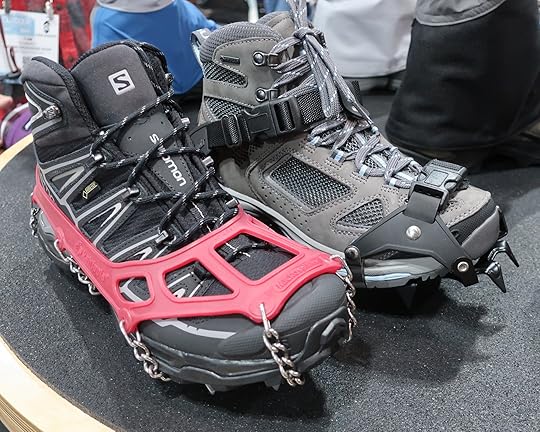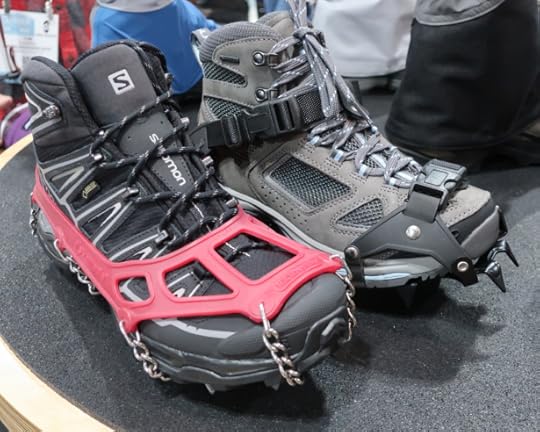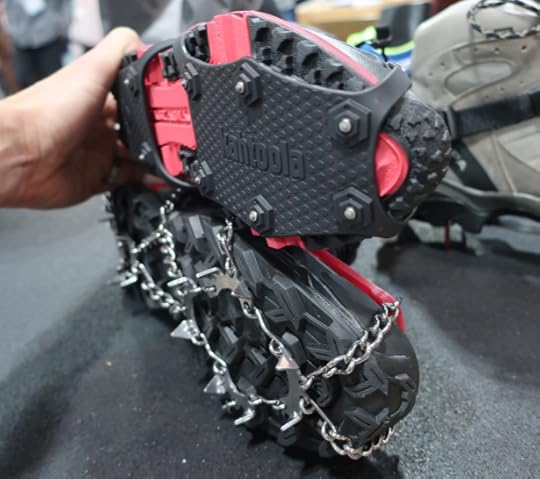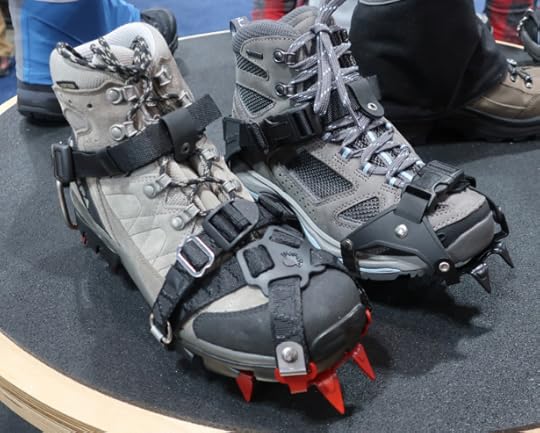Buyer’s Guide: Kathoola Microspikes vs K-10 and KTS Crampons || Differences, intended uses, and limitations


The Microspikes (left) are best for ice and consolidated snow. They are also light, reasonably priced, and easy to put on and take off. The K10 Crampons are more suitable for steeper slopes and softer snow.
Kahtoola was showing off its new gaiters at the Outdoor Retailer tradeshow, but I was more interested in its time-tested traction devices. These spikes and crampons are crux for:
Running on snow- and ice-covered trails and roads; and,
Hiking on glacial ice, crust-covered snowpack, or steep-ish lingering snowfields.
All the Kahtoola devices are compatible with soft-soled boots and shoes. Unlike conventional crampons, they do not require a stiff sole or a special heel piece. This makes them ideal for runners and hikers who prefer to wear soft, comfortable shoes.
I traded stories and insights with Ric from Kahtoola to better understand the differences, intended uses, and limitations of these products.
Kahtoola Microspikes
$70
12 oz +/- depending on the size
Four sizes
Twelve 3/8-inch spikes
More information
Nearly every trail runner in Boulder owns the Kahtoola Microspikes. They are lightweight and compact, quick to put on and take off, and very effective on ice and compacted snow. Especially at the higher elevations and on shady aspects, Boulder’s foothills trails can become luge runs or skating rinks during the winter. Running or hiking without Microspikes is an invitation for a concussion, or just simply impossible.
For pure ice, the Kahtoola Nanospikes work equally well. But they struggle in any kind of snow, and therefore are not as popular.

The Nanospikes (top) work well on ice, but don’t offer enough bite for snow.
The Microspikes have been worn successfully by backpackers on the Wind River High Route, which requires non-technical glacier travel (i.e. no ropes or crevasse risk), and on popular long-distance trails in early-season conditions like the Pacific Crest and John Muir Trail. Imagine, for example, trying to climb or descend an established boot track up to or down from a 12,000-foot pass early in the morning before the snow has softened up.
In unconsolidated snow and soft spring snow, the 3/8-inch spikes reach their limit, unable to provide reliable purchase. They would be a poor pick for, say, the Sierra High Route, which gets much less traffic (and therefore has no boot tracks) and tackles steeper terrain. It certainly can be done, but Microspikes would not be a first-choice.

The Micropikes (top) versus the K10 Crampons
Kahtoola K10 Crampons
$100
21.5 oz
One size
Ten 3/4-inch spikes
More information
The K10 are ideal for hiking on steep-ish slopes in early-season conditions, especially on routes without established boot tracks: the longer 3/4-inch spikes bite better than the Microspikes into softer, less consolidated snow.
What does “steep-ish” mean? Personally, I’ll get on slopes up to about 45 degrees, but my tolerance is probably higher than most.
The sharp steel spikes of the K10 will stick to compacted snow and ice just as well as the Microspikes. However, they’re almost twice as heavy, more time-consuming to put on and take off, and less comfortable to wear than the Microspikes. So they’d be overkill for Boulder’s foothills trails and for the John Muir Trail in most years.
The K10 Crampons are available commercially in just one size. It will fit men’s hiking boots between sizes 6 and 13, and women’s in 7 to 14. If you use a trail running shoe, you can probably have a bigger size (maybe up to 14 in men’s and 15 in women’s); if you wear a large boot, it’s the reverse. If you fall outside these ranges, contact Kahtoola for a LeafSpring Flex Bar in size XS or XL.

The K10 Crampons (right) are simpler, lighter, and less expensive than the KTS. For most early-season backpacking, they are the more appropriate pick.
KTS Crampons
$170
23.3 oz
One size
Ten 1-inch spikes
More information
The original Kahoola product is slightly more capable than the K10 Crampons, with 1-inch spikes, a trianguled buckle closure system, and a more engineered heel piece. But the KTS Crampons are excessive for nearly all backpackings. Moreover, it’s a few ounces heavier and $70 more expensive than the K10. It’s better suited for lightweight mountaineering.

The K10 has a simpler heel, part of why it retails for $100 instead of the $170 for KTS.
Have questions about or an experience with Kahtoola products, or with similar ones? Leave a comment.
Disclosure. This website is supported mostly through affiliate marketing, whereby for referral traffic I receive a small commission from select vendors, at no cost to the reader. This post contains affiliate links. Thanks for your support.
The post Buyer’s Guide: Kathoola Microspikes vs K-10 and KTS Crampons || Differences, intended uses, and limitations appeared first on Andrew Skurka.



